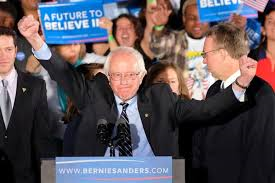
(Credit: usnews.com)
If there’s one thing that fires up Bernie Sanders supporters—and makes his detractors roll their eyes—it’s his call for a “political revolution.” To his base, it’s the very point of his anti-establishment, anti-elite candidacy. To his critics, it’s the very embodiment of his campaign’s naïve impracticality and vagueness.
But now that voters in Iowa and New Hampshire have spoken, it’s time to take the idea of political revolution more seriously—more seriously, indeed, when Sanders himself appears to have. It’s time to ask: What exactly would it take?
It starts with Congress. And here it’s instructive to compare Sanders and Donald Trump. Both rely on broad, satisfying refrains of “We’re gonna”: We’re gonna break up the big banks. We’re gonna make Mexico build the wall. We’re gonna end the rule of Wall Street billionaires. We’re gonna make China stop ripping us off.
The difference is, Trump’s refrains are more plausible. That’s because today’s Congress is already willing to enact many of his proposals, whether repeal of Obamacare or severe restrictions on immigration. And if Trump became president, the 115th Congress would very likely be more conservative than the 114th.
For Sanders to deliver on his “We’re gonna” pledges, he needs an entirely different Congress. How to get it? Thus far, Sanders has laid out a theory of action that is basically, “If I come, they will build it.” That is, if he electrifies enough voters to win, then presumably those voters will have upended Congress as well. He’s banking on an electoral flood tide à la 1980, 1964, or 1932.
That’s possible, but it’s not a plan. If he’s serious about political revolution, the first priority for Sanders now should be to cultivate a crop of Democratic candidates who can oust Republican incumbents. House Democrats, at their lowest numbers since 1947, need 30 seats to regain a majority. If Sanders launched a “Bernie’s 30” effort, to persuade his formidable base of small donors to give money and time to a slate of candidates who can win a targeted set of seats now held by the GOP, that would help effect the actual institutional change his presidency would depend on.
A second step for a true revolution would be a common policy agenda for all these candidates. Here he could take a page from Newt Gingrich’s playbook and issue a progressive Contract With America that prioritizes 10 easy-to-digest legislative goals (Wall Street reform, campaign reform, single-payer health care, and so forth). Historians and commentators differ on how much the Contract truly caused the tectonic 1994 GOP takeover. But it did nationalize, and standardize, congressional campaigns in a way that Sanders would need to do.
Third, Sanders should also take a page from the Obama 2008 playbook. That campaign organized young people more systematically than any presidential campaign in history. Across the country, it held “Camp Obama” trainings, in which young people taught each other Marshall Ganz’s story-centered methods of community organizing. Sanders has the young people; now he needs the machinery to amplify their force.
Fourth, Sanders would have to learn from Obama 2008 how to catalyze culture makers. Every presidential campaign knows enough now to enlist celebrity musicians or artists. But Sanders could invite artists from all around the country, famous or not, to create work that spreads the message of his campaign. Culture shapes norms: about inequality, racism, violence. And culture that isn’t made by the campaign but by the people packs a punch.
Fifth, Sanders would have to link up to other organic movements that are arising in parallel with his own campaign. The Democracy Awakening coalition, led by the NAACP and Public Citizen with dozens of other progressive organizations, for example, is planning a national rally in Washington for this spring. But Sanders should look beyond obviously progressive movements. If he wants a revolution, he needs also to invite in the segment of Trump supporters who aren’t racist xenophobes but who simply feel left behind by a changing country. That would be revolutionary.
Sixth, the Sanders campaign should study the Tea Party closely and learn from it. It’s too easy for progressives to dismiss the Tea Party as a creation of the Koch brothers. The more complex and instructive reality is that, especially early on, there were many thousands of Americans self-organizing on conference calls and Facebook and in person. What was their leadership structure? How did they communicate? What lessons do their grassroots leaders have about dealing with the party establishment?
Seventh, Sanders should be building a web of city leaders—elected and not—who will push policies in sync with his national agenda. Cities are increasingly the locus of civic innovation, whether on the sharing economy or living wages or criminal-justice reform. A true political revolution would activate citizens in every city of scale to provide the foundation from which federal reforms could arise.
Of course, Hillary Clinton could adopt some of these strategies, too. But her disadvantage is that she does not have many young voters. More crucially, she does not seek transformational change. The only other candidate who wants such change, Trump, sees his voters as an audience, as customers, as fans. Not so much as citizens. He loves them the way Il Duce loved his people. He wants to exercise power in their name, not to empower them to shape their own futures.
Which brings me back to the Sanders opportunity—and what I think of as an American opportunity. I supported Obama in 2008, and I’ve supported Clinton this time. But I am genuinely excited about the energy Sanders has activated, and I believe it’s good for the country if that energy gets converted to productive civic action.
So the message now to Bernie Sanders from Americans of every stripe should be this: You say you want a revolution? Help us make one.

